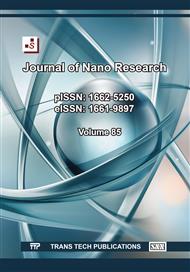[1]
Kuan, H.T.N.; Tan, M.Y.; Shen, Y. and Yahya, M.Y. Mechanical properties of particulate organic natural filler-reinforced polymer composite: A review. Composites and Advanced Materials. (2021), 30, p.2634.
DOI: 10.1177/26349833211007502
Google Scholar
[2]
Wang, M.J.; Wolff, S. and Tan, E.H. Filler-elastomer interactions. Part VIII. The role of the distance between filler aggregates in the dynamic properties of filled vulcanizates. Rubber chemistry and technology. (1993), 66(2), pp.178-195.
DOI: 10.5254/1.3538305
Google Scholar
[3]
Schaefer, D.W. and Justice, R.S. How nano are nanocomposites? Macromolecules, (2007), 40(24), pp.8501-8517.
DOI: 10.1021/ma070356w
Google Scholar
[4]
Prucker, O. and Rühe, J. Mechanism of radical chain polymerizations initiated by azo compounds covalently bound to the surface of spherical particles. Macromolecules. (1998), 31(3), pp.602-613.
DOI: 10.1021/ma970661p
Google Scholar
[5]
Rühe, J. January. Polymers grafted from solid surfaces. In Macromolecular Symposia. (1998), 126, (1), pp.215-222). Basel: Hüthig & Wepf Verlag.
DOI: 10.1002/masy.19981260117
Google Scholar
[6]
Zhang, Z.; Sèbe, G.; Hou, Y.; Wang, J.; Huang, J. and Zhou, G. Grafting polymers from cellulose nanocrystals via surface‐initiated atom transfer radical polymerization. Journal of Applied Polymer Science. (2021), 138(48), p.51458.
DOI: 10.1002/app.51458
Google Scholar
[7]
Eskandari, P.; Abousalman-Rezvani, Z.; Roghani-Mamaqani, H.; Salami-Kalajahi, M. and Mardani, H. Polymer grafting on graphene layers by controlled radical polymerization. Advances in Colloid and Interface Science. (2019), 273, p.102021.
DOI: 10.1016/j.cis.2019.102021
Google Scholar
[8]
Lacerda, P.S.; Gama, N.; Freire, C.S.; Silvestre, A.J. and Barros-Timmons, A. Grafting poly (methyl methacrylate)(PMMA) from cork via atom transfer radical polymerization (ATRP) towards higher quality of three-dimensional (3D) printed PMMA/Cork-g-PMMA materials. Polymers. (2020), 12(9), p.1867.
DOI: 10.3390/polym12091867
Google Scholar
[9]
Matyjaszewski, K. Advanced materials by atom transfer radical polymerization. Advanced Materials. (2018), 30(23), p.1706441.
DOI: 10.1002/adma.201706441
Google Scholar
[10]
Vivek, A.V. and Dhamodharan, R. Grafting of methacrylates and styrene on to polystyrene backbone via a "grafting from" ATRP process at ambient temperature. Journal of Polymer Science Part A: Polymer Chemistry. (2007), 45(17), pp.3818-3832.
DOI: 10.1002/pola.22131
Google Scholar
[11]
Pyun, J.; Jia, S.; Kowalewski, T.; Patterson, G.D. and Matyjaszewski, K. Synthesis and characterization of organic/inorganic hybrid nanoparticles: kinetics of surface-initiated atom transfer radical polymerization and morphology of hybrid nanoparticle ultrathin films. Macromolecules, (2003), 36(14), pp.5094-5104.
DOI: 10.1021/ma034188t
Google Scholar
[12]
Liu, C.H. and Pan, C.Y. Grafting polystyrene onto silica nanoparticles via RAFT polymerization. Polymer. (2007),48(13), pp.3679-3685.
DOI: 10.1016/j.polymer.2007.04.055
Google Scholar
[13]
Li, S.; Han, G. and Zhang, W. Photoregulated reversible addition–fragmentation chain transfer (RAFT) polymerization. Polymer Chemistry. (2020), 11(11), pp.1830-1844.
DOI: 10.1039/d0py00054j
Google Scholar
[14]
Moad, G. A critical survey of dithiocarbamate reversible addition‐fragmentation chain transfer (RAFT) agents in radical polymerization. Journal of Polymer Science Part A: Polymer Chemistry.(2019), 57(3), pp.216-227.
DOI: 10.1002/pola.29199
Google Scholar
[15]
Tsagaropoulos, G.; Eisenberg, A. Dynamic mechanical study of the factors affecting the two glass tranistion behavior of filled polymers . Macromolecules. (1995), 28, 396–398.
DOI: 10.1021/ma00122a011
Google Scholar
[16]
Arrighi, V.; McEwen, I. J.; Qian, H.; Serrano Prieto, M. B. The glass transition and interfacial layer in styrene-butadiene rubber containing silica nanofiller. Polymer (2003), 44, 6259–6266.
DOI: 10.1016/s0032-3861(03)00667-0
Google Scholar
[17]
Yeong, Suk Choi, Mingzhe, Xu. Synthesis of exfoliated poly(styrene-co-acrylonitrile) copolymer/silicate nanocomposite by emulsion polymerization; monomer composition effect on morphology. Polymer (2003), 44, 6989–6994.
DOI: 10.1016/j.polymer.2003.08.020
Google Scholar
[18]
Ko, M. Effects of acrylonitrile content on the properties of clay-dispersed poly(styrene-co-acrylonitrile) copolymer nanocomposite. Polymer Bulletin. (2000), 45, 183–190.
DOI: 10.1007/pl00006833
Google Scholar
[19]
Vivek, G.; Tirtha, C.; Lindsay, B; ombalski, Y.; Krzysztof, M.; Ramanan, K.Viscoelastic properties of silica-grafted poly(styrene–acrylonitrile) nanocomposites. Polym Sci Part B: Polym Phys.(2006),44,2014–2023.
DOI: 10.1002/polb.20827
Google Scholar
[20]
Queffelec, J.; Gaynor, S.G.; Matyjaszewski, K. Optimization of atom transfer radical polymerization using Cu(I)/tris(2-(dimethylamino)ethyl)amine as a Catalyst. Macromolecules, (2000), 33, 8629.
DOI: 10.1021/ma000871t
Google Scholar
[21]
Antoni, P.; Nyström, D.; Malmström, E.; Johansson, M.; Hult, A. Synthesis of polystyrene grafting filler nanoparticles, Polym. Prepr. , (2005), 46(1), 477.
Google Scholar
[22]
Victoria A.; Hans W.; Horn, Gavin O.; Jones, E.; Robert, D. Synthesis of diblock copolymers by combination of organocatalyzed ring-opening polymerization and atom transfer radical polymerization using trichloroethanol as a bifunctional initiator. J. Polym. Sci., Part A: Polym. Chem. (2016), 54, 563–569.
DOI: 10.1002/pola.27807
Google Scholar
[23]
Khlifa, M.; Youssef, A.; Zaed, F.; Kraft, A.; Arrigh, V. Synthesis of polystyrene grafting filler nanoparticles: effect of grafting on mechanical reinforcement. International Journal of chemical and molecular engineering,(2014),8,12
Google Scholar
[24]
Ohno,K.; Morinaga,T.; Koh. K.; Tsujii, Y.; Fukuda,T. Synthesis of monodisperse silica particles coated with well-defined, high-density polymer brushes by surface-initiated atom transfer radical polymerization. Macromolecules, (2005), 38, 2137.
DOI: 10.1021/ma048011q
Google Scholar
[25]
Li, M.; Min, K.; and Matyjaszewski, K. Simultaneous Reverse & Normal ATRP (SR&NI). Macromolecules. (2004), 37, 2106-2112.
DOI: 10.1021/ma035284x
Google Scholar
[26]
Ojha, S.; Hui, C. M.; Matyjaszewski, K.; and Bockstaller, M. R. Grafting PMMA brushes from α-alumina nanoparticles via SI-ATRP. Mater. Interfaces, (2016), 8 (8), 5458–5465.
DOI: 10.1021/acsami.5b12311
Google Scholar
[27]
Dong, H.; Tang, W. and Matyjaszewski, K. Kinetics of Atom Transfer radical polymerisation. Macromolecules. (2007), 40, 2974-2977.
Google Scholar
[28]
akubowski, W.; and Matyjaszewski, K. Activator Generated by Electron Transfer for Atom Transfer Radical Polymerisation. Macromolecules (2015), 38, 4139-4146.
DOI: 10.1021/ma047389l
Google Scholar
[29]
Pietrasik, J.; Dong, H.; Matyjaszewski, K. Synthesis of high molecular weight poly(styrene-co-acrylonitrile) copolymers with controlled architecture. Macromolecules, (2006), 39, 6384.
DOI: 10.1021/ma0611927
Google Scholar
[30]
Ha, M. L. P.; Grady, B.P.; Lolli, G.; Resasco, D. E.; Ford, W. T. Composites of single‐walled carbon nanotubes and styrene‐isoprene copolymer. Macromol. Chem. Phys. (2007), 208, 446–456.
DOI: 10.1002/macp.200600521
Google Scholar
[31]
Sugimoto, H.; Daimatsu, K.; Nakanishi, E.; Ogasawara, Y.; Yasumura, T.; Inomata, K. Preparation and properties of poly(methylmethacrylate)–silica hybrid materials incorporating reactive silica nanoparticles. Polymer (2006), 47, 3754–3759.
DOI: 10.1016/j.polymer.2006.04.002
Google Scholar


